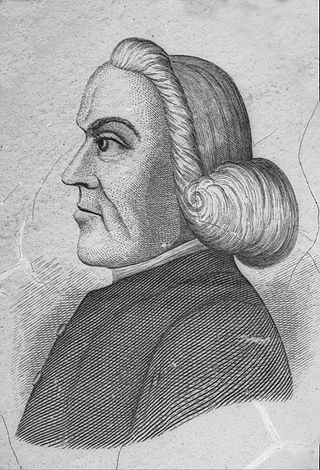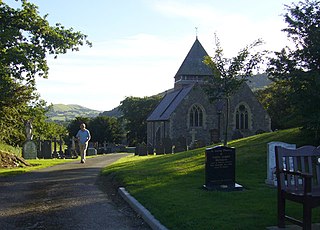
Llansantffraed (Llansantffraed-juxta-Usk) is a parish in the community of Talybont-on-Usk in Powys, Wales, near Brecon. The benefice of Llansantffraed with Llanrhystud and Llanddeiniol falls within the Diocese of St Davids in the Church in Wales.

Howell Harris was a Calvinistic Methodist evangelist. He was one of the main leaders of the Welsh Methodist revival in the 18th century, along with Daniel Rowland and William Williams Pantycelyn.

Ewenny Priory, in Ewenny in the Vale of Glamorgan, Wales, was a monastery of the Benedictine order, founded in the 12th century. The priory was unusual in having extensive military-style defences and in its state of preservation; the architectural historian John Newman described it as “the most complete and impressive Norman ecclesiastical building in Glamorgan”. Following the Dissolution of the Monasteries, parts of the priory were converted into a private house by Sir Edward Carne, a lawyer and diplomat. This Elizabethan house was demolished between 1803 and 1805 and replaced by a Georgian mansion, Ewenny Priory House. The house is still owned by the Turbervill family, descendants of Sir Edward. The priory is not open to the public apart from the Church of St Michael, the western part of the priory building, which continues to serve as the parish church for the village. The priory is in the care of Cadw and is a Grade I listed building.

Talgarth is a market town, community and electoral ward in southern Powys, Mid Wales, about 12 miles (19 km) north of Crickhowell, 19 miles (31 km) north-east of Brecon and 15 miles (24 km) south-east of Builth Wells. Notable buildings in the town include the 14th-century parish church and a defensive tower house. According to traditional accounts, Talgarth was the capital of the early medieval kingdom of Brycheiniog. It is in the historic county of Brecknockshire. In 2011, it had a population of 1,724.

Powis Castle is a medieval castle, fortress and grand country house near Welshpool, in Powys, Wales. The seat of the Herbert family, earls of Powis, the castle is known for its formal gardens and for its interiors, the former having been described as "the most important", and the latter "the most magnificent", in the country. The castle and gardens are under the care of the National Trust. Powis Castle is a Grade I listed building, while its gardens have their own Grade I listing on the Cadw/ICOMOS Register of Parks and Gardens of Special Historic Interest in Wales.
Trefeca, located between Talgarth and Llangorse Lake in what is now south Powys in Wales, was the birthplace and home of the 18th-century Methodist leader Howell Harris (1714–1773),. It was also the site of two Calvinistic Methodist colleges at different times; the first sponsored by Selina, Countess of Huntingdon in the late eighteenth century; the second supported by the Welsh Calvinistic Methodist Connexion in the later nineteenth century.

Llandinam is a village and community in Montgomeryshire, Powys, central Wales, between Newtown and Llanidloes, located on the A470. As a community, Llandinam is made up of the village itself, small hamlets including Plas Dinam and Little London and several farms. The village itself has a population of around 576 with 56% born in Wales.

Three Cocks or Aberllynfi is a village near Glasbury in Powys, Wales. The Welsh name refers to the mouth of the Afon Llynfi which enters the River Wye a mile from the village. The nearest town is Hay-on-Wye some 5 miles (8.5 km) to the northeast.

Hay Castle is a medieval fortification and 17th-century mansion house in the small town of Hay-on-Wye in Powys, Wales. Originally constructed as part of the Norman invasion of Wales, the castle was designed as a ringwork overlooking the town in either the late-11th or early-12th centuries. It was rebuilt in stone around 1200 by the de Braose family and then had a turbulent history, being attacked and burnt several times during the First and Second Barons' Wars, the wars with the Welsh princes, the rebellion of Owain Glyndŵr and the Wars of the Roses. In the 17th century a Jacobean mansion house was built alongside the medieval keep and the property became a private home. Serious fires in 1939 and 1977 gutted the castle and, despite repairs in the 1980s, by the 21st century much of the building was derelict and unstable. Since 2011 it has been owned by Hay Castle Trust who have restored the property to form a centre for arts, literature and learning. Following the restoration, partly funded by grants from the National Lottery Heritage Fund of over £5m, the castle opened to the public on 26 May 2022.

Treowen is an early 17th-century house in Monmouthshire, Wales, regarded as "the most important gentry house in the county". It is located in open countryside within the parish of Wonastow, about ½ mile (1 km) north-east of the village of Dingestow, and 3 miles (4.8 km) south-west of Monmouth. After being used as a farmhouse for three centuries, Treowen now operates as a conference and functions venue and holds the annual Wye Valley Chamber Music Festival. It is a Grade I listed building, and its gardens are designated Grade II on the Cadw/ICOMOS Register of Parks and Gardens of Special Historic Interest in Wales.

In the United Kingdom, the term listed building refers to a building or other structure officially designated as being of special architectural, historical, or cultural significance; Grade I structures are those considered to be "buildings of exceptional interest". Listing was begun by a provision in the Town and Country Planning Act 1947. Once listed, strict limitations are imposed on the modifications allowed to a building's structure or fittings. In Wales, the authority for listing under the Planning Act 1990 rests with Cadw.

Moynes Court is a Grade II* listed building in the village of Mathern, Monmouthshire, Wales, about 3 miles (4.8 km) south west of Chepstow. An earlier building was rebuilt as a private residence by Francis Godwin, Bishop of Llandaff, in about 1609/10, and much of the building remains from that period. Its grounds contain earthworks thought to be the foundations of an earlier moated manor house. The gatehouse to the court has a separate Grade II* listing. The garden at the court is on the Cadw/ICOMOS Register of Parks and Gardens of Special Historic Interest in Wales.
Domen Fawr, or Tafolwern Castle was a motte-and-bailey castle of the Middle Ages. It is situated in Tafolwern, near Llanbrynmair in Powys. It is registered with Cadw as monument MG065 and is a scheduled monument.

Old Trecastle Farmhouse, Pen-y-clawdd, Monmouthshire is a farmhouse, originally, a gentry house, dating from the 16th and 17th centuries. It stands on the site of the outworks of a Norman motte-and-bailey castle. The house is Grade II* listed.

Penpont is a seventeenth-century Grade I listed manor house in the Usk valley between Brecon and Sennybridge in Powys, Wales. It was built by Daniel Williams on the site of, and perhaps incorporating, an earlier house, Abercamlais-isaf. The frontage dates from 1815. Penpont Bridge, a grade II* listed structure, spans the Usk by means of four segmented stone arches. The gardens at Penpont are influenced by Repton but have a long history from the seventeenth century with the addition of a celebrated Green Man maze in recent years. They are listed Grade II* on the Cadw/ICOMOS Register of Parks and Gardens of Special Historic Interest in Wales.

Penarth-fawr, in the community of Llanystumdwy, Gwynedd, Wales is a medieval hall house dating from the mid 15th century. Described in the Gwynedd Pevsner as "an important medieval hall house", Penarth-fawr is a Grade I listed building and a scheduled monument.

The farm at Great Porthamel, at Talgarth in Powys, Wales, comprises a range of buildings including the farmhouse, the gate tower and an agricultural building. They form the remnants of a major medieval manor that was the principal seat of the Vaughan family. The complex has been described as "one of the more remarkable mediaeval houses of Wales". The gatehouse is a Grade I listed building, and a scheduled monument, while the farmhouse is listed at Grade II* and the agricultural building at Grade II.

Powys is a county and preserved county in Wales. It covers an area of 5,180 km2 (2,000 sq mi) and in 2021 the population was approximately 133,600.
















